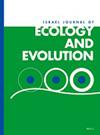陕西省4个植被带优势灌木叶、茎、根性状的关系
IF 0.8
4区 环境科学与生态学
Q3 ECOLOGY
引用次数: 10
摘要
叶、茎和根作为植物的主要器官,具有特定的功能,共同调节生存、生长和繁殖。这些器官之间的关系是研究的重点,关于它们之间的权衡,有很多假设。然而,这些假设的结果是不一致和令人困惑的。在本研究中,我们检测了27种优势灌木的叶、茎和木质根的15个核心性状,并进一步检验了这些器官之间关系的假设。对陕西省沙漠、草原、温带森林和亚热带森林等9个地区的灌木进行了测定。不同器官性状之间存在许多显著相关性,如氮和磷含量在器官内或器官间均呈显著正相关。此外,结构性状(碳含量和干物质含量)和矿物质营养性状(氮和磷含量)的代表性在叶、茎和根之间表现出显著的正相关。本研究结果支持了叶与根、茎与根之间存在显著相关性的假设。同样,我们发现叶和茎加根之间的权衡显示出显著的相关性。因此,难以测量的根系性状与叶和茎的性状相协调。我们得出的结论是,在研究权衡时,灌木的叶片成分是整个植物的一个很好的替代品,它可以通过关注叶片经济谱来提供一种理解整个植物经济谱的方便方法。本文章由计算机程序翻译,如有差异,请以英文原文为准。
Relationships among Leaf, Stem and Root Traits of the Dominant Shrubs from Four Vegetation Zones in Shaanxi Province, China
Leaves, stems and roots as the main plant organs have specific functions and together modulate survival, growth and reproduction. The relationships between these organs are high research priority, and there have been many hypotheses about the trade-offs between them. However, the results of these hypotheses are inconsistent and confusing. In this study, we examined 15 core traits of leaves, stems and woody roots of 27 dominant shrub species and further tested the hypotheses about the relationships between these organs. Measurements were made for shrubs across 9 sites including desert, steppe, temperate forest and subtropical forest in Shaanxi Province of China. Many significant correlations of different organ traits were found, e.g. nitrogen and phosphorus content showed a significant positive correlation, either within or across organs. Also, representatives of structural traits (carbon content and dry matter content) and mineral nutrient traits (nitrogen and phosphorus content) showed significant positive correlations among the leaves, stems and roots. The results of this study supported the hypotheses that there were significant correlations between leaf and root and between stem and root. Similarly, we found that trade-off between leaf and stem-plus-root showed a significant correlation. Thus, root traits, which are difficult to measure, are coordinated with those of the leaf and stem. We conclude that the leaf component of shrubs is a good proxy for the whole-plant in studying trade-offs and it could provide a convenient way to understand the whole-plant economic spectrum by focusing on the leaf economic spectrum.
求助全文
通过发布文献求助,成功后即可免费获取论文全文。
去求助
来源期刊

Israel Journal of Ecology & Evolution
环境科学-进化生物学
CiteScore
2.10
自引率
0.00%
发文量
7
审稿时长
>36 weeks
期刊介绍:
The Israel Journal of Ecology and Evolution includes high-quality original research and review papers that advance our knowledge and understanding of the function, diversity, abundance, distribution, and evolution of organisms. We give equal consideration to all submissions regardless of geography.
 求助内容:
求助内容: 应助结果提醒方式:
应助结果提醒方式:


